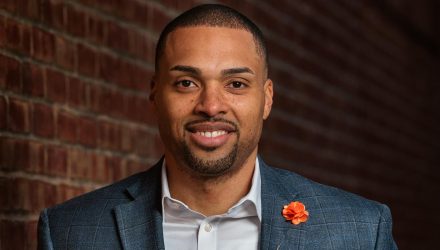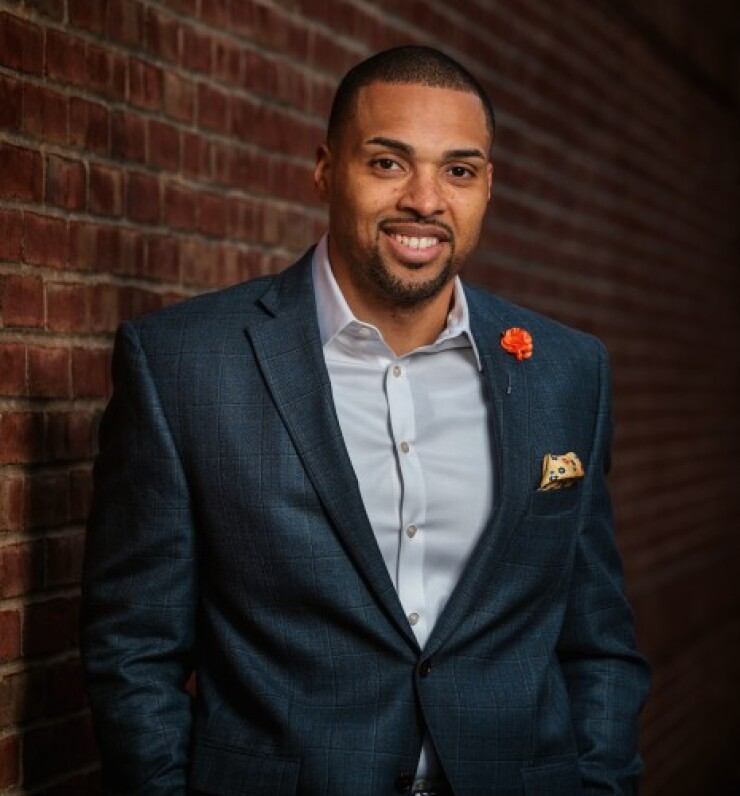Tyrone Ross is the founder and president of 401 Financial, CEO of crypto-data company Turnqey Labs, former CEO of Onramp Invest, and host of Nasdaq’s “Queue and A” show for financial advisors. He’s been among the “top” people of interest, according to FinancialPlanning.com, Investment News, and Investopedia, and is a well-known figure in the ETF and advisory space. We sat down with Tyrone to discuss why he’s chosen to launch a very different kind of financial planning practice focused on flat fees and access.
Dave Nadig, Financial Futurist at VettaFi: Tyrone, it’s great to chat with you. For those who haven’t seen your name before, please give us the tl;dr on the Tyrone Ross story.
Tyrone Ross, founder and president of 401 Financial: Well, first, I describe myself as the son of superhero parents, Carol and Tyrone Ross Senior. I’m a proud first-generation high school graduate and a three-time failed Olympian. Right now, I am CEO and co-founder of Turnqey Labs, a crypto data company, and the principal and founder of 401 Financial, a registered investment advisor for the next generation.
Nadig: Ok, so let’s dig right in. You started your career in the pretty traditional trenches — in the Merrill Lynch training program — and today, you’re running an RIA that couldn’t be more different, charging a $500 a month flat fee.
That’s extraordinarily unusual. I’ve only talked to a handful of advisors ever that have taken that approach. Why do it this way? At the risk of being blunt, why do you think you’re going to have as successful of a business doing it?
Ross: I love it. So, a couple of things.
I’ll go back to when I was interviewing for the job at Merrill. I sat in the interview, and they slid this piece of paper across the table and said to write down 20 people you know that have $250,000. At that moment, I was introduced to the fact that it’s a $250,000 minimum to do business there.
I slid the paper right back.
There was no one that I knew that had that kind of money, and I realized as I started to go through the training program that I was turning away a lot of people who looked, walked, talked, and acted like me — people that needed help that I couldn’t help in my role at the time.
When I left Merrill, I said, “Okay, I want to provide more access.” There were a couple of things that bothered me about how advising was being done — the first is the term “wealth management.” It’s inherently exclusive, which is why we don’t use it at 401.
If I’m walking by “Merrill Lynch Wealth Management,” I’m personally going to keep walking. Wealth! It’s not for me, and what I hear as a Black American is my folks always saying, “it’s not for us.” The stock market? Not for us. Advisors? Not for us. I got tired of hearing that.
Second, I also had a problem with AUM pricing. The model was “sit on the same side of the table, you don’t make money unless we make money.” I remember all those pitches! Kudos to advisors who are doing it, I just don’t think that fits for me.
Flat Fees and Deconstructing Industry Standards
Nadig: So you’ve done away with AUM fees entirely? Is it just the $500 monthly retainer?
Ross: We’re non-discretionary advisors. We don’t trade for you or bill you on how big you are. We’re going after that 25- to 45-year-old segment — we’ll go younger, we’ll go a little older, but they aren’t high earners, they’re not rich yet. They don’t have that asset base to move to us, but we know we want to provide full-blown financial planning, so every client gets that.
We wanted to give investment management all bundled into $500 a month, and if they can’t pay it, we do it for free. Also, 10% of our fees will be donated to a charity.
When my partner and I sat down to do this, we said we weren’t doing it to make money. We were just doing this because we want to kick a hole in the industry standard and say this could be done. Planning it out, I knew the first thing everyone would scream about is if it was going to scale — especially when I told him we’re only taking 25 clients to start.
Here’s what I also know now, which I didn’t before, which is why timing is divine.
Access to capital changes things because if I have access to capital, I can tinker with an idea — hello Silicon Valley — to build products that fit the market. As I start to show what works, other folks will buy in.
What this meant was that as I was out pitching Turnqey, a lot of investors are asking, “are you taking money for 401?” Nope, we’re just going to build it from scratch, but they kept saying, “are you going to take some money for 401?” I eventually said, “yes, I am.”
The reason why all of it works is that we have capital in the bank, so we’re not forced to do all the things that we would need to do to scale it; we have the money.
Nadig: You don’t have to break even this month, right?
Ross: Exactly, and here’s the cool part: we’re already profitable! Why? Because our tech stack is not 40 different things, and we have relationships with some of the platforms we’re using that bought into the vision and are giving us “first year free” trials. We’re already profitable right now, and then we’ll scale and get bigger.
The whole goal was to ensure everyone who wanted financial planning could get financial planning — you should have a family office in your pocket. Here’s the other cool thing: we just announced a partnership with Wealth.com, through which our clients get estate planning for free.
Our goal over time is to bring our fee down, not increase it. We’ll only take it to zero, hopefully, because we’ll have other lines of business. Since we don’t charge on assets, fees don’t change. You keep the assets where they are, we just see them. We’ll guide you on it, but you make the trades, you do it yourself, and you get everything from us for $500 a month, no added cost whatsoever, with the expectation that, eventually, those fees will decrease.
A Foundation Built on Financial Access for All
Nadig: Ok, so let me challenge that model for a minute. Aren’t you locking yourself out of a certain client base where $500 a month is just legitimately not going to be enough money to pay you to manage a more complicated client? I’ve talked to some advisors who spent all their time buried in trust documentation. I’ve seen how complicated wealthy investors’ lives can get. Are you limiting the audience?
Ross: Yes, purposely. Everyone else chases the ultra-high-net-worth, everyone else serves them. Why would we go after that same market, right?
That said, we do have one family office that’s an investor, and one of them is actually coming to us to be a client. His net worth will probably break our workflows, but it’s going to be an example to show that we can work with that type of clientele. We have all the resources to be able to do it, and the reason they’ll want to work with us is that they’ll realize they can do everything from their phone in real-time, and they’re getting the “family office” experience for only $500 a month.
If we’re shutting ourselves out from the ultra-high net worth, I’m okay with that. 90 plus percent of our clients right now are working with an advisor for the first time, and that’s what I want, folks who want to work with an advisor for the first time.
Nadig: In most cases, that means working with a family. You and I have talked before about how someone’s family’s experience with money becomes their experience, and how hard that is to break. Where do you put education into the mix with a new client?
Ross: My whole thing with that is beyond giving your kids what you made, give them what you didn’t have — and “what you didn’t have” is a lot. They’re often the first in the family ever to have made money, but what didn’t you have along the way to creating that wealth? Give that to your children. I think I have a very bespoke perspective in that sense because of where I come from.
The other way I look at it is this: if our industry is really going to become what I think it can become — the most beloved industry in the world — there’s going to have to be this realization of the true human approach to financial conversations.
I ask every new client one question; “what is your first memory of money?” Is it sitting on your dad’s lap, watching CNBC? Or is it like me with the landlord destroying the door because he wants rent money, and as a family, you don’t have it? That kind of creates a framework around how, as an adult, you function in that realm with money.
Our goal at 401 is to go back to square one and work on your existing relationship with money. When you get it, what’s the first thing that you do? Then we can talk about the transfer of wealth or transfer of any asset, transfer of education, and transfer of experience.
I have this conversation with very wealthy people all the time, and they always come to me and say, “Tyrone, you know, my kids are living the life I never had, and they’re doing really well, but I’m worried about them struggling.” I tell them, “Well, there’s the one thing you can never give them: struggle.”
You can’t buy struggle.
My mother could stretch $20 from May to September! That’s a really strong characteristic to have around money — the scarcity of it and the ability to stretch it.
What we hope to do is say, “alright, how do we sit with these wealthier families or those that are inheriting wealth, or that first generation of wealth and start to build these principles and core values around how you separate ‘the money’ from ‘the work?'” How do we start to help people build constructs very early around feelings around money and taboos around money?
Nadig: Tyrone, I can’t imagine anyone better situated to have those conversations than you. Really appreciate you taking some time with us.
For more news, information, and analysis, please visit VettaFi | ETF Trends.

